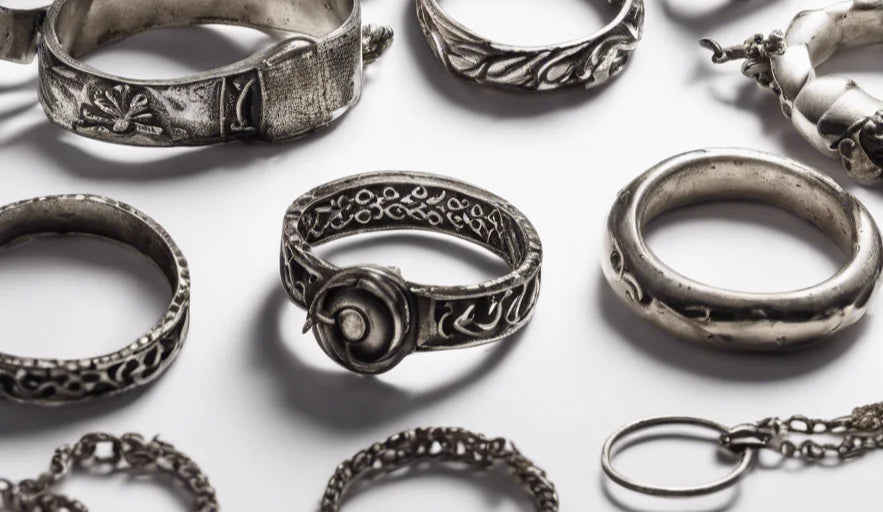
Why Silver Turns Black: Quick Solutions Explained
Why Does Silver Tarnish? A Closer Look at the Science Behind Silver’s Darkening
Silver, a precious metal known for its beauty and luster, has one notable drawback—it tarnishes over time. This tarnishing is primarily due to a chemical reaction between silver and sulfur compounds in the air. When silver comes into contact with sulfur or sulfur-containing substances, it forms silver sulfide (Ag₂S), a black compound that causes the dark discoloration we often see on silver items. Let's explore the various factors that contribute to this tarnishing process and how to prevent it.
The Science of Silver Tarnishing
At the heart of tarnishing is a process called oxidation, though silver doesn’t directly react with oxygen. Instead, the key culprit is sulfur. The sulfur compounds in the air, such as hydrogen sulfide (H₂S), bond with the silver on the surface of the item, forming silver sulfide. Over time, this black coating grows, dulling the shine of silver and leading to a less appealing appearance.
But why does this happen? Silver is a relatively reactive metal, though it resists corrosion better than many other metals like iron. However, when it encounters sulfur, the bond formed between the two elements is strong enough to change the surface of the silver item from shiny to dull and blackened.
Factors That Accelerate Tarnishing
While sulfur exposure is the primary cause of tarnishing, several external factors can accelerate or worsen the process. Understanding these factors can help in the preservation and maintenance of silver items.
-
Humidity and Moisture: Moisture in the air plays a significant role in facilitating the tarnishing process. In high-humidity environments, the presence of water can act as a catalyst, speeding up the reaction between sulfur compounds and silver. For this reason, silver items stored in humid areas tarnish much faster than those in dry, controlled environments.
-
Air Pollution: Industrial areas, where sulfur-containing compounds like hydrogen sulfide (H₂S) and sulfur dioxide (SO₂) are more prevalent, can be especially harsh on silver. Pollutants in the air from car exhaust, factories, and even power plants all contribute to tarnishing. The more polluted the air, the more likely your silver is to encounter higher levels of sulfur compounds, leading to faster and more severe tarnishing.
-
Skin Oils and Sweat: The human body naturally produces oils and sweat, which can contain small amounts of sulfur compounds. When silver jewelry or utensils come into frequent contact with skin, these oils transfer onto the silver. Over time, the accumulated oils and sweat can speed up tarnishing, especially if the silver isn't cleaned regularly. This is why silver jewelry often tarnishes more quickly when worn frequently.
-
Sulfur-Rich Foods: Certain foods are rich in sulfur and can promote tarnishing when they come into direct contact with silver items like utensils or serving dishes. Eggs, onions, garlic, and certain leafy greens are common offenders. For example, if silver cutlery is used with eggs, the sulfur in the egg yolk can cause noticeable darkening after just one meal. Therefore, avoiding contact with sulfur-rich foods is one way to reduce tarnishing in daily use.
-
Household Cleaning Products: Surprisingly, some cleaning products can cause tarnishing rather than prevent it. Many cleaning agents, especially those containing sulfur-based compounds, can leave residue on silver items, which accelerates tarnishing over time. Even certain polishes, if not properly formulated for silver, can do more harm than good. It’s essential to use silver-specific cleaning products to avoid introducing tarnishing agents.
How to Prevent Silver from Tarnishing
While silver tarnishing is inevitable, there are steps you can take to minimize and slow the process:
-
Use Anti-Tarnish Storage Solutions: One of the simplest ways to protect silver is by storing it in anti-tarnish bags or cloths. These materials are treated to absorb sulfur and other compounds in the air before they reach the silver. Keeping silver in a sealed, dry environment will also reduce exposure to moisture and airborne pollutants.
-
Keep Silver Dry: Storing silver in low-humidity environments or using dehumidifiers in rooms where silver is stored can slow tarnishing significantly. After using or cleaning silver, make sure to dry it thoroughly before storing it.
-
Avoid Prolonged Contact with Skin: When not wearing silver jewelry, remove it to prevent oils and sweat from building up on its surface. Regularly wipe down jewelry with a soft cloth to remove any oils after wearing.
-
Watch Out for Sulfur-Containing Foods: If you use silver utensils or serving pieces with sulfur-rich foods, wash and dry them immediately after use to prevent tarnish from setting in.
-
Regular Cleaning: Even with precautions, tarnish will likely form over time. Regular cleaning with a silver polish or a mixture of baking soda and water can help remove tarnish and restore silver’s shine. Be gentle when cleaning to avoid scratching the surface of your silver.
Conclusion
Tarnishing is a natural process that all silver items undergo, but it can be managed and minimized through proper care. By understanding the causes of tarnish—sulfur exposure, humidity, air pollution, skin contact, sulfur-rich foods, and inappropriate cleaning products—you can take steps to protect your silver and keep it shining for years to come. With just a little effort, you can preserve your silver’s brilliance and beauty, allowing it to remain a cherished part of your collection!
